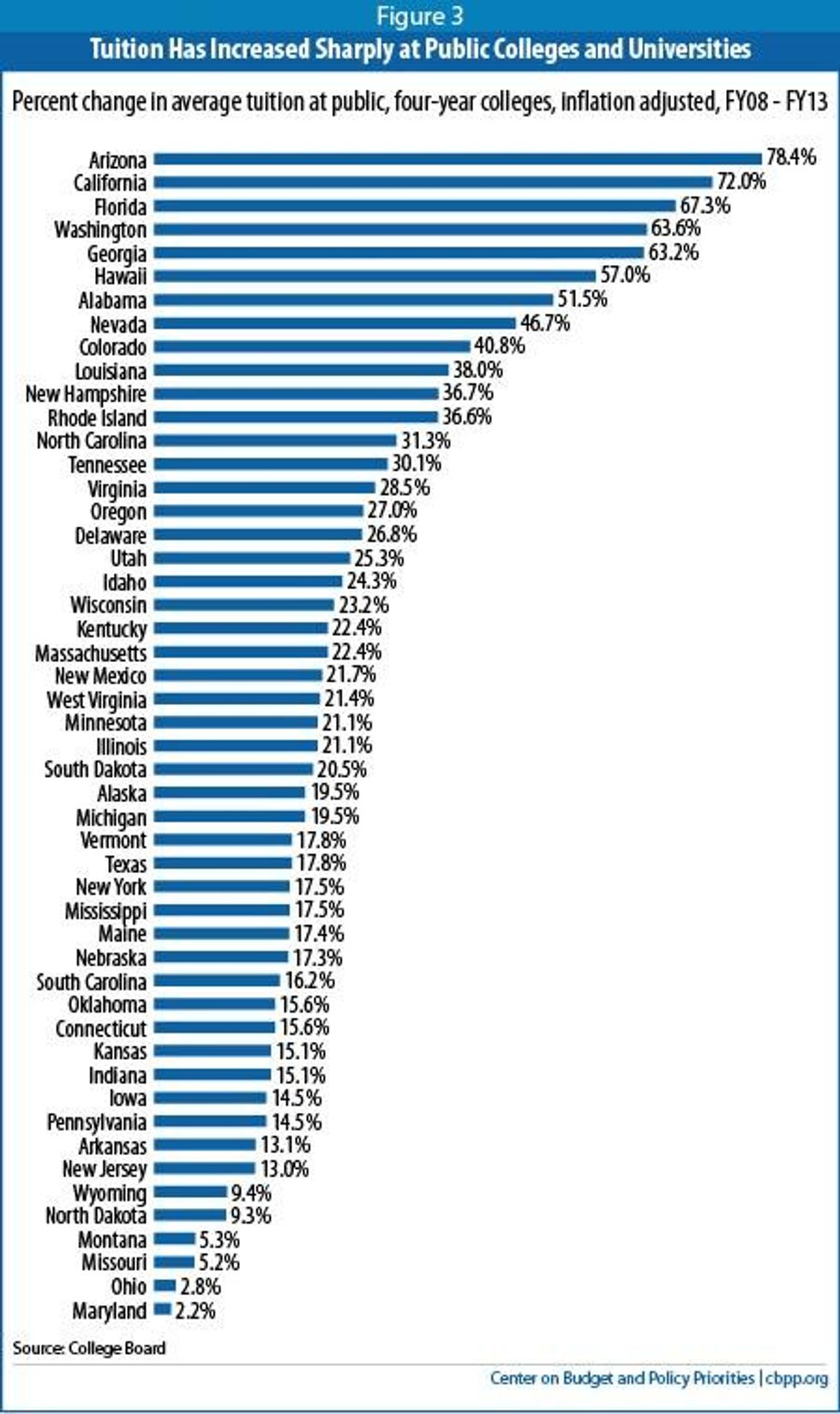Report: State Education Cuts Causing 'Surge' in University Tuition Prices
Higher education tuition hikes disproportionately impact low-income students
The gross slashing of funds for public universities has caused a "surge" in tuition prices, disproportionately impacting low-income students says a new report from the Center on Budget and Policy Priorities (CBPP).

States are spending an average of 28 percent less this year on public university funding than they did in 2008--a decrease of $2,353 per student. According to CBPP, thirty-six states cut funding by over 20 percent and eleven slashed their budgets by more than one-third. Arizona and New Hampshire have cut their higher education spending in half.
To compensate for this massive gap in funding, the burden of cost has shifted to students in the form of surging tuition which, at four-year public colleges, has grown 27 percent since the 2007-08 year.
"These numbers are a vivid demonstration of why Washington's post-recession path has been so disastrous," said the Atlantic's Jordan Weissman in response to the report.
According to the report:
Average annual tuition at four-year public colleges has grown by $1,850, or 27 percent, since the 2007-08 school year when adjusted for inflation. In seven states -- Arizona, California, Florida, Washington, Georgia, Hawaii, and Alabama -- average tuition has increased by more than 50 percent. In Arizona and California, tuition has risen by more than 70 percent.
"It's very clear that rising costs dissuade students from attending college, particularly students from low-income families," said CBPP policy analyst Phil Oliff on a call with reporters. Citing a 1995 study by Harvard University researcher Thomas Kane, CBPP notes that states that had the largest tuition increases during the 1980's and early 1990's "saw the greatest widening of the gaps in enrollment between high- and low-income youth."
Compounding these rising costs, the rate of growth for public university tuition has outpaced the growth in median household income nearly 159 to 3 percent between 1991 and 2011, leaving students and families beholden to mounting levels of debt to cover the exploding cost of schools.
According to CBPP:
Between the 2007-08 and the 2010-11 school years, the amount of debt incurred by the average bachelor's degree recipient at a public four-year institution grew from $11,800 to $13,600 (in 2011 dollars), an inflation adjusted increase of $1,800, or 15 percent. The average level of debt incurred had grown from $11,100 to $11,800, an increase of $700, or about 6 percent, over the previous eight years.
"We're going to be living with the effects of these cuts for a long time," added Weissman. "We'll see them in the form of higher student loan bills and students who can't graduate on time, because the classes they needed filled up too quickly."
The report concludes that these disturbing figures will have widespread impacts on an already weak national education system and consequently, states' future economic success. "At the very least," the authors write, "states must avoid shortsighted tax cuts, which would make it much harder for them to invest in higher education, strengthen the skills of their workforce, and compete for the jobs of the future."
_____________________
An Urgent Message From Our Co-Founder
Dear Common Dreams reader, The U.S. is on a fast track to authoritarianism like nothing I've ever seen. Meanwhile, corporate news outlets are utterly capitulating to Trump, twisting their coverage to avoid drawing his ire while lining up to stuff cash in his pockets. That's why I believe that Common Dreams is doing the best and most consequential reporting that we've ever done. Our small but mighty team is a progressive reporting powerhouse, covering the news every day that the corporate media never will. Our mission has always been simple: To inform. To inspire. And to ignite change for the common good. Now here's the key piece that I want all our readers to understand: None of this would be possible without your financial support. That's not just some fundraising cliche. It's the absolute and literal truth. We don't accept corporate advertising and never will. We don't have a paywall because we don't think people should be blocked from critical news based on their ability to pay. Everything we do is funded by the donations of readers like you. Will you donate now to help power the nonprofit, independent reporting of Common Dreams? Thank you for being a vital member of our community. Together, we can keep independent journalism alive when it’s needed most. - Craig Brown, Co-founder |
The gross slashing of funds for public universities has caused a "surge" in tuition prices, disproportionately impacting low-income students says a new report from the Center on Budget and Policy Priorities (CBPP).

States are spending an average of 28 percent less this year on public university funding than they did in 2008--a decrease of $2,353 per student. According to CBPP, thirty-six states cut funding by over 20 percent and eleven slashed their budgets by more than one-third. Arizona and New Hampshire have cut their higher education spending in half.
To compensate for this massive gap in funding, the burden of cost has shifted to students in the form of surging tuition which, at four-year public colleges, has grown 27 percent since the 2007-08 year.
"These numbers are a vivid demonstration of why Washington's post-recession path has been so disastrous," said the Atlantic's Jordan Weissman in response to the report.
According to the report:
Average annual tuition at four-year public colleges has grown by $1,850, or 27 percent, since the 2007-08 school year when adjusted for inflation. In seven states -- Arizona, California, Florida, Washington, Georgia, Hawaii, and Alabama -- average tuition has increased by more than 50 percent. In Arizona and California, tuition has risen by more than 70 percent.
"It's very clear that rising costs dissuade students from attending college, particularly students from low-income families," said CBPP policy analyst Phil Oliff on a call with reporters. Citing a 1995 study by Harvard University researcher Thomas Kane, CBPP notes that states that had the largest tuition increases during the 1980's and early 1990's "saw the greatest widening of the gaps in enrollment between high- and low-income youth."
Compounding these rising costs, the rate of growth for public university tuition has outpaced the growth in median household income nearly 159 to 3 percent between 1991 and 2011, leaving students and families beholden to mounting levels of debt to cover the exploding cost of schools.
According to CBPP:
Between the 2007-08 and the 2010-11 school years, the amount of debt incurred by the average bachelor's degree recipient at a public four-year institution grew from $11,800 to $13,600 (in 2011 dollars), an inflation adjusted increase of $1,800, or 15 percent. The average level of debt incurred had grown from $11,100 to $11,800, an increase of $700, or about 6 percent, over the previous eight years.
"We're going to be living with the effects of these cuts for a long time," added Weissman. "We'll see them in the form of higher student loan bills and students who can't graduate on time, because the classes they needed filled up too quickly."
The report concludes that these disturbing figures will have widespread impacts on an already weak national education system and consequently, states' future economic success. "At the very least," the authors write, "states must avoid shortsighted tax cuts, which would make it much harder for them to invest in higher education, strengthen the skills of their workforce, and compete for the jobs of the future."
_____________________
The gross slashing of funds for public universities has caused a "surge" in tuition prices, disproportionately impacting low-income students says a new report from the Center on Budget and Policy Priorities (CBPP).

States are spending an average of 28 percent less this year on public university funding than they did in 2008--a decrease of $2,353 per student. According to CBPP, thirty-six states cut funding by over 20 percent and eleven slashed their budgets by more than one-third. Arizona and New Hampshire have cut their higher education spending in half.
To compensate for this massive gap in funding, the burden of cost has shifted to students in the form of surging tuition which, at four-year public colleges, has grown 27 percent since the 2007-08 year.
"These numbers are a vivid demonstration of why Washington's post-recession path has been so disastrous," said the Atlantic's Jordan Weissman in response to the report.
According to the report:
Average annual tuition at four-year public colleges has grown by $1,850, or 27 percent, since the 2007-08 school year when adjusted for inflation. In seven states -- Arizona, California, Florida, Washington, Georgia, Hawaii, and Alabama -- average tuition has increased by more than 50 percent. In Arizona and California, tuition has risen by more than 70 percent.
"It's very clear that rising costs dissuade students from attending college, particularly students from low-income families," said CBPP policy analyst Phil Oliff on a call with reporters. Citing a 1995 study by Harvard University researcher Thomas Kane, CBPP notes that states that had the largest tuition increases during the 1980's and early 1990's "saw the greatest widening of the gaps in enrollment between high- and low-income youth."
Compounding these rising costs, the rate of growth for public university tuition has outpaced the growth in median household income nearly 159 to 3 percent between 1991 and 2011, leaving students and families beholden to mounting levels of debt to cover the exploding cost of schools.
According to CBPP:
Between the 2007-08 and the 2010-11 school years, the amount of debt incurred by the average bachelor's degree recipient at a public four-year institution grew from $11,800 to $13,600 (in 2011 dollars), an inflation adjusted increase of $1,800, or 15 percent. The average level of debt incurred had grown from $11,100 to $11,800, an increase of $700, or about 6 percent, over the previous eight years.
"We're going to be living with the effects of these cuts for a long time," added Weissman. "We'll see them in the form of higher student loan bills and students who can't graduate on time, because the classes they needed filled up too quickly."
The report concludes that these disturbing figures will have widespread impacts on an already weak national education system and consequently, states' future economic success. "At the very least," the authors write, "states must avoid shortsighted tax cuts, which would make it much harder for them to invest in higher education, strengthen the skills of their workforce, and compete for the jobs of the future."
_____________________

